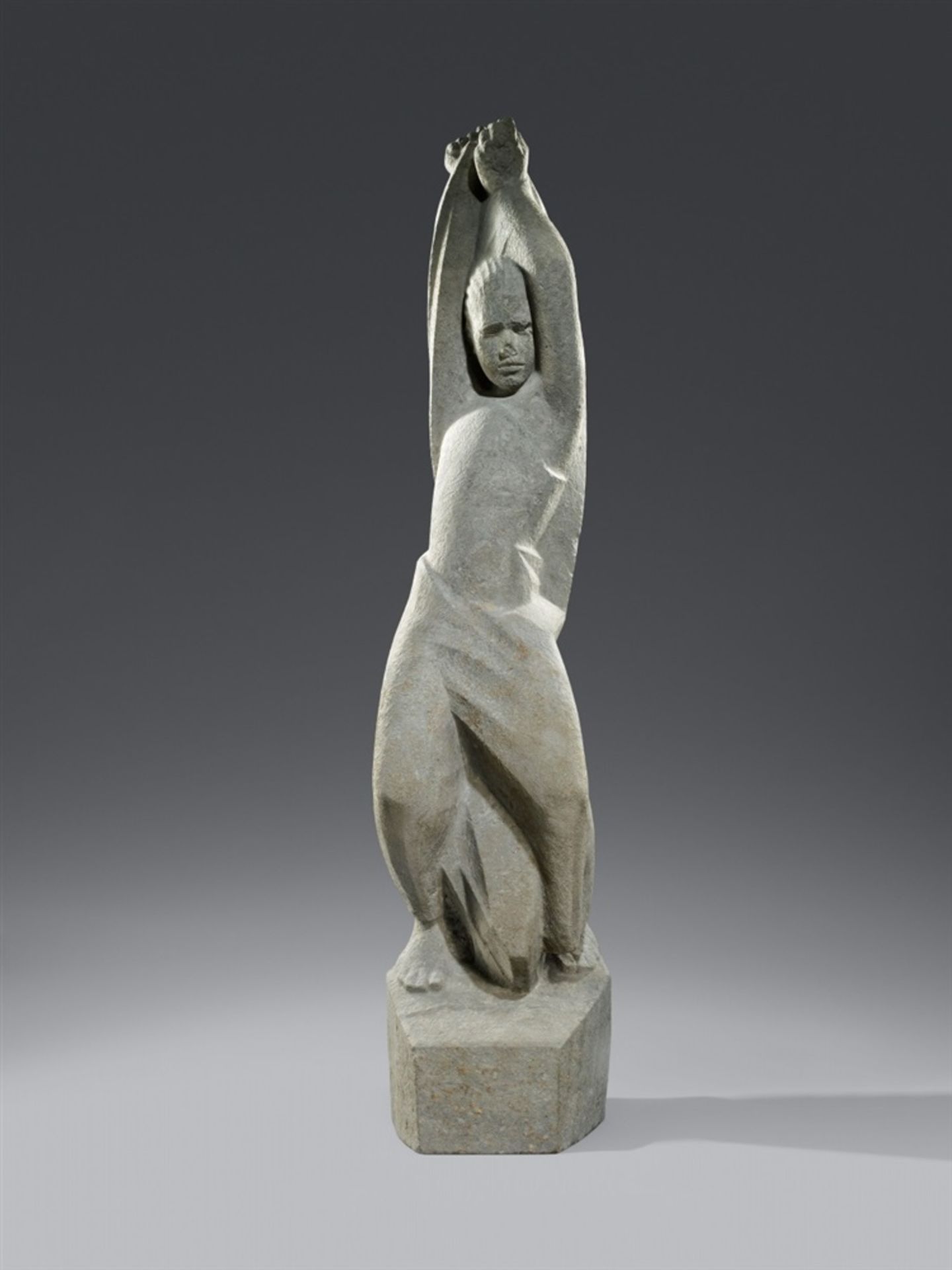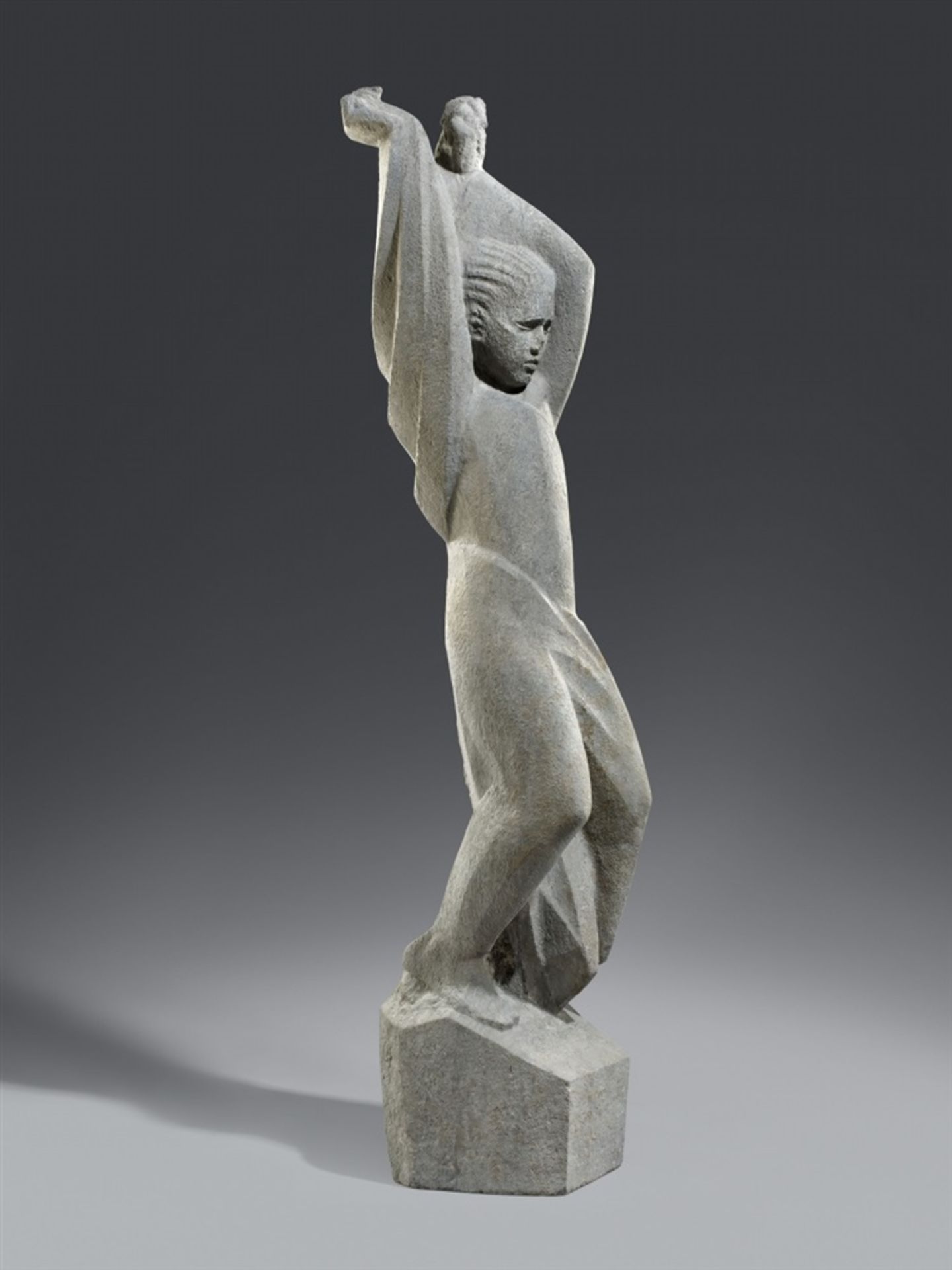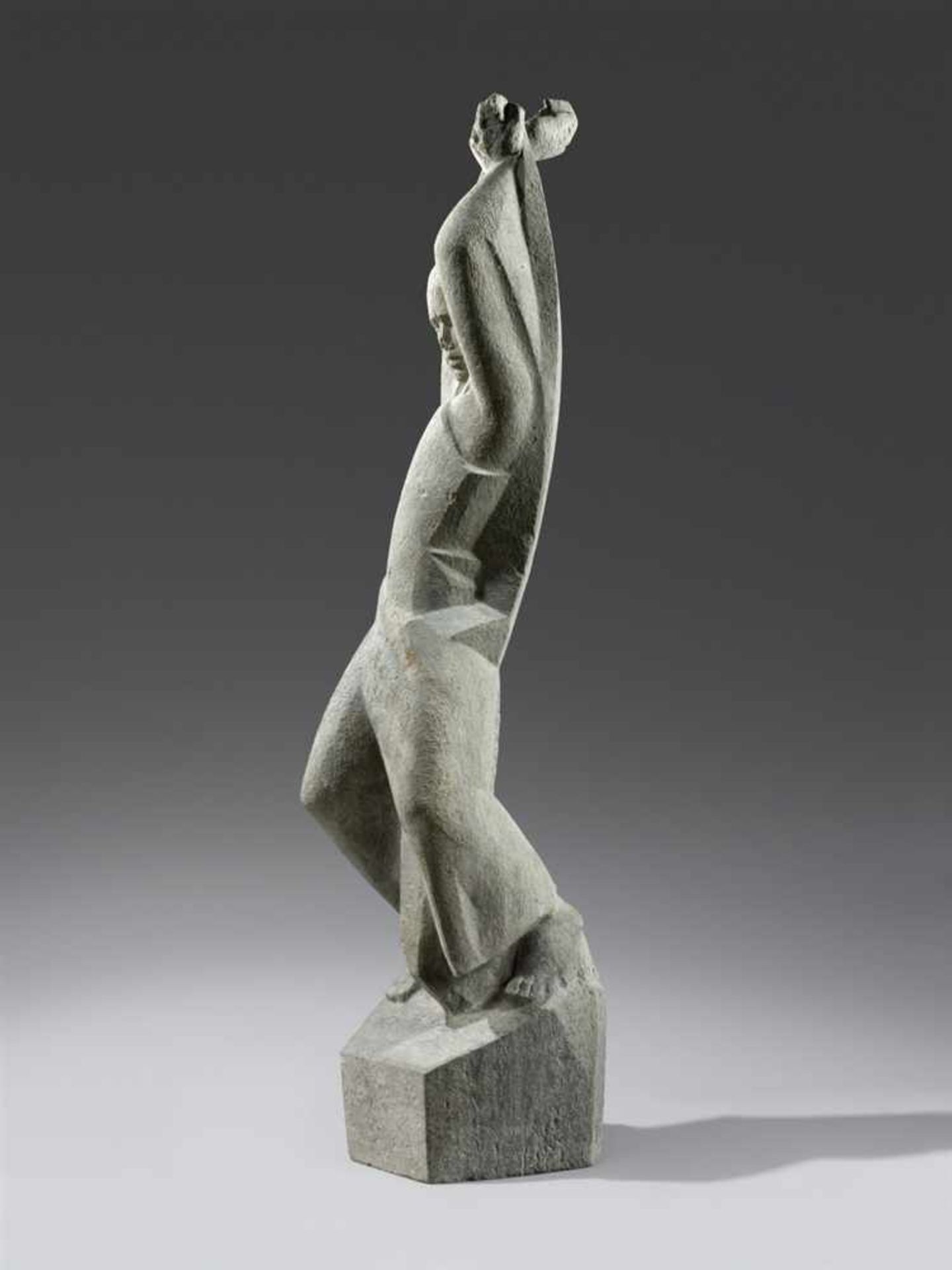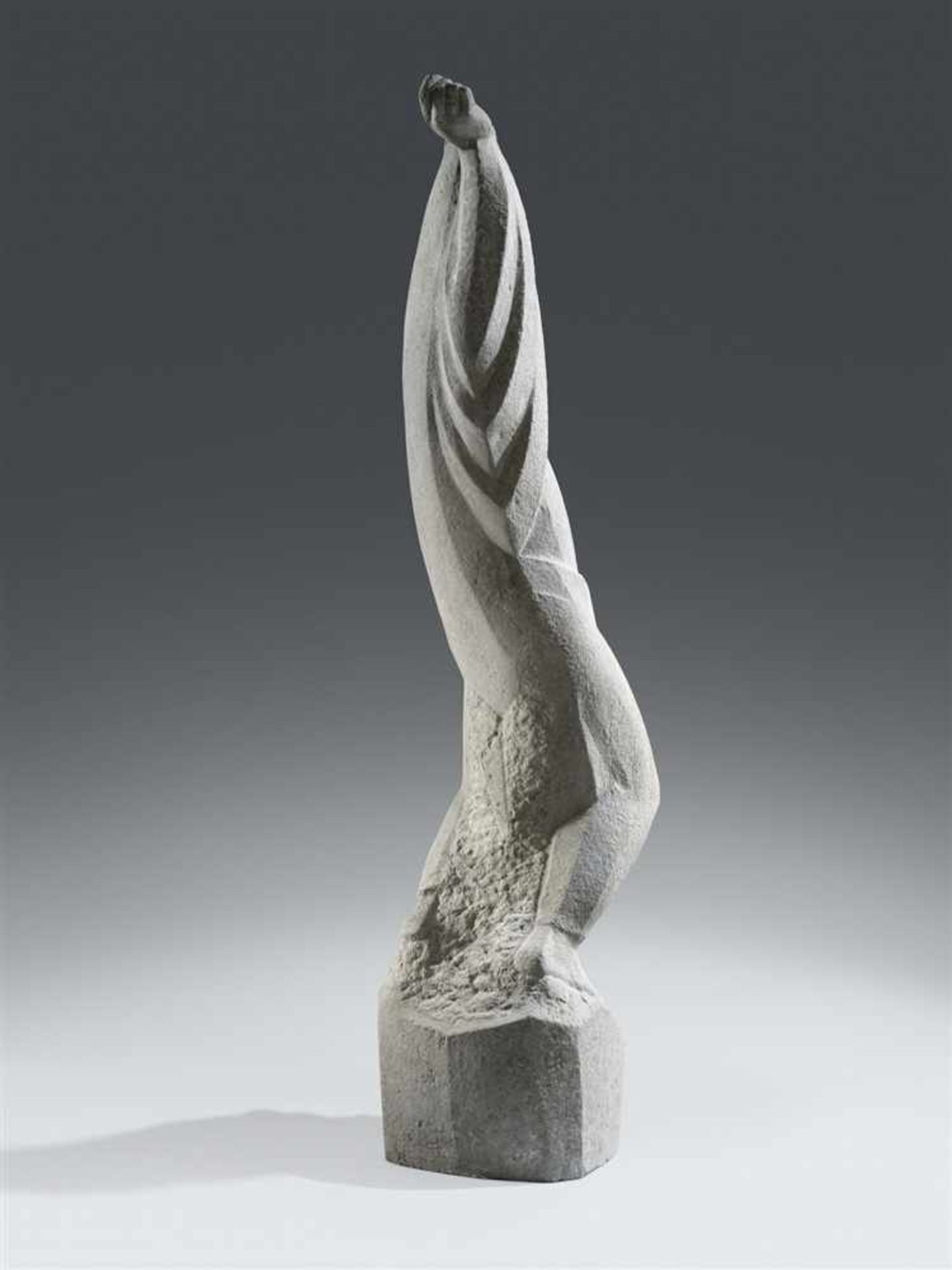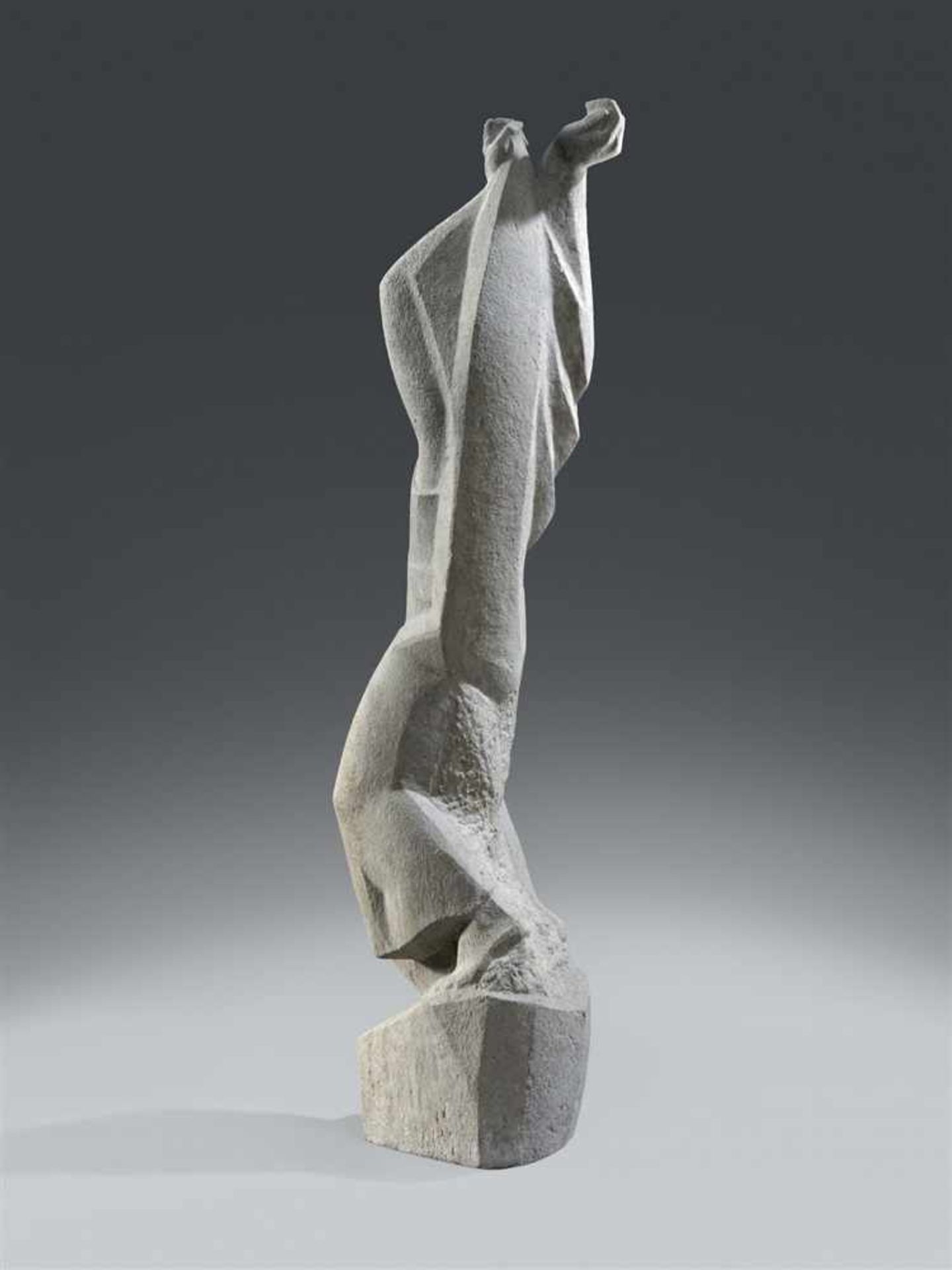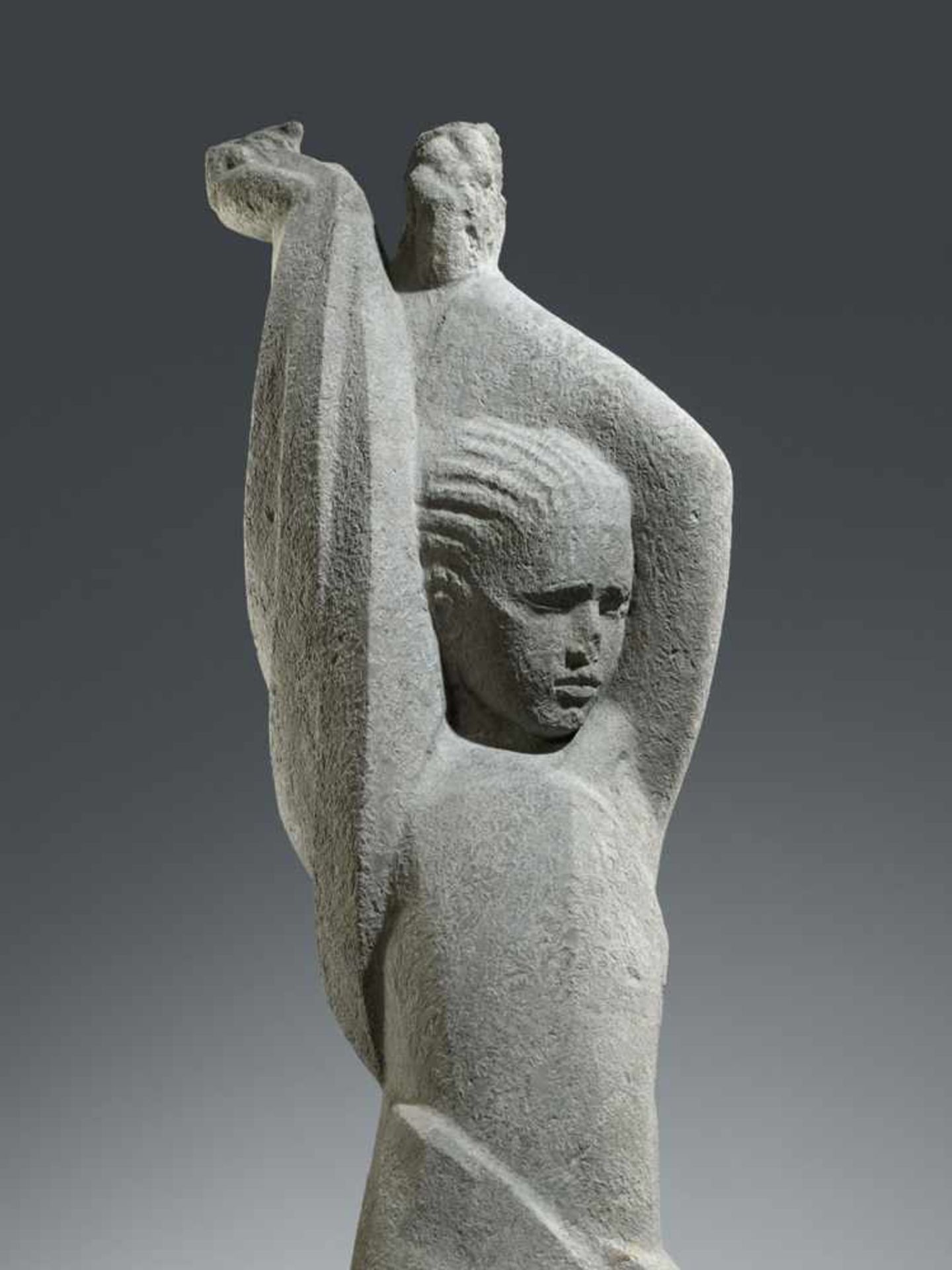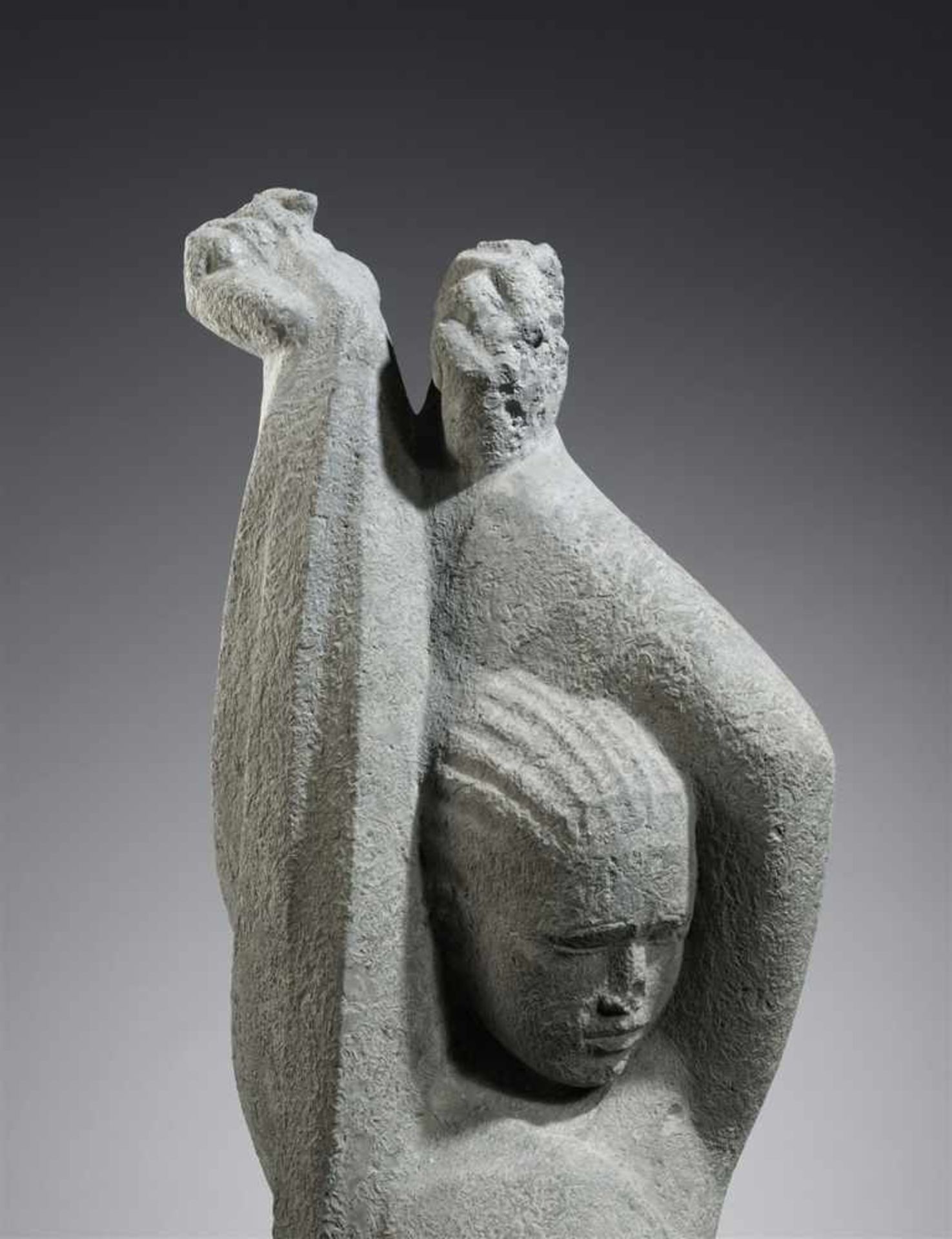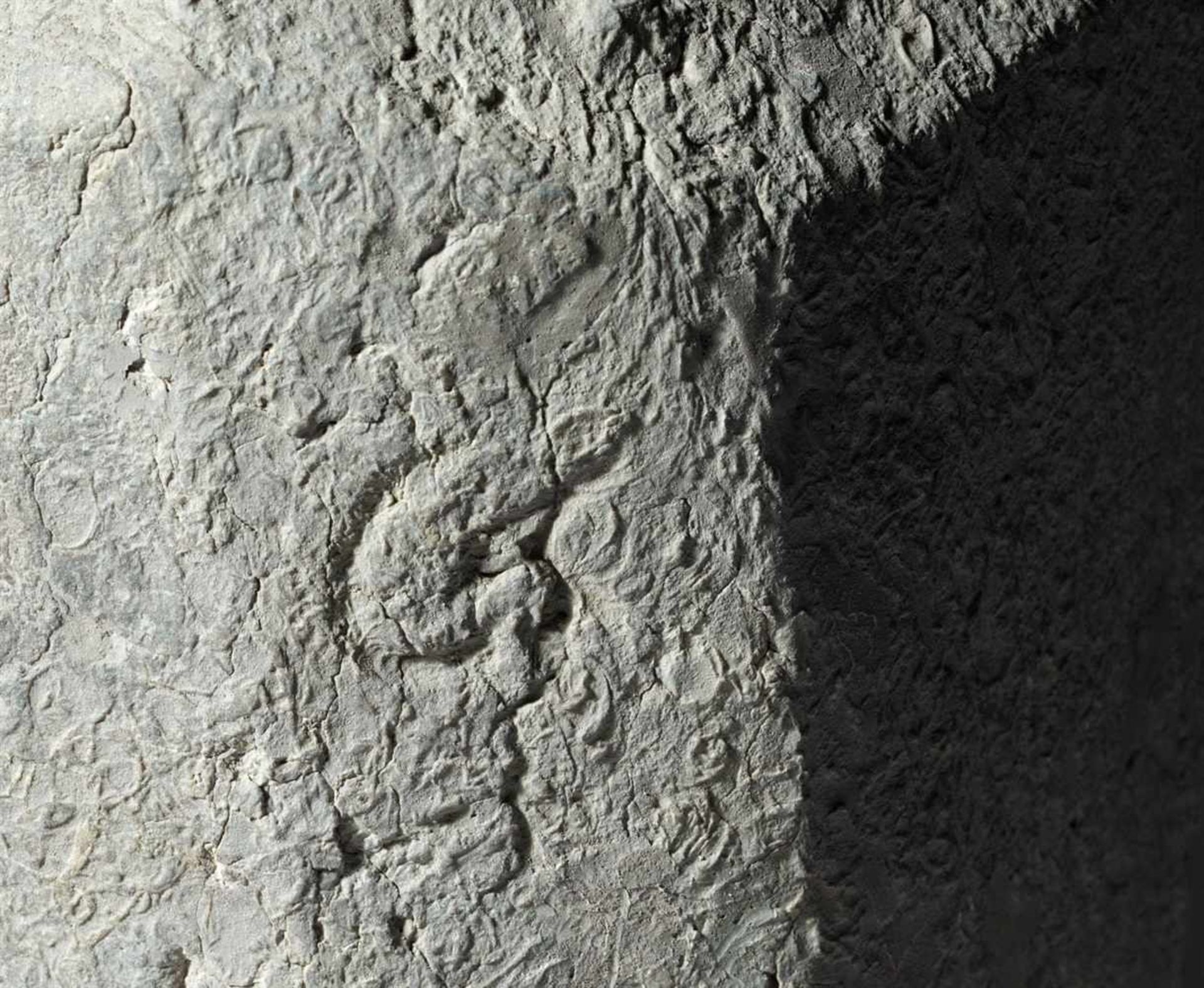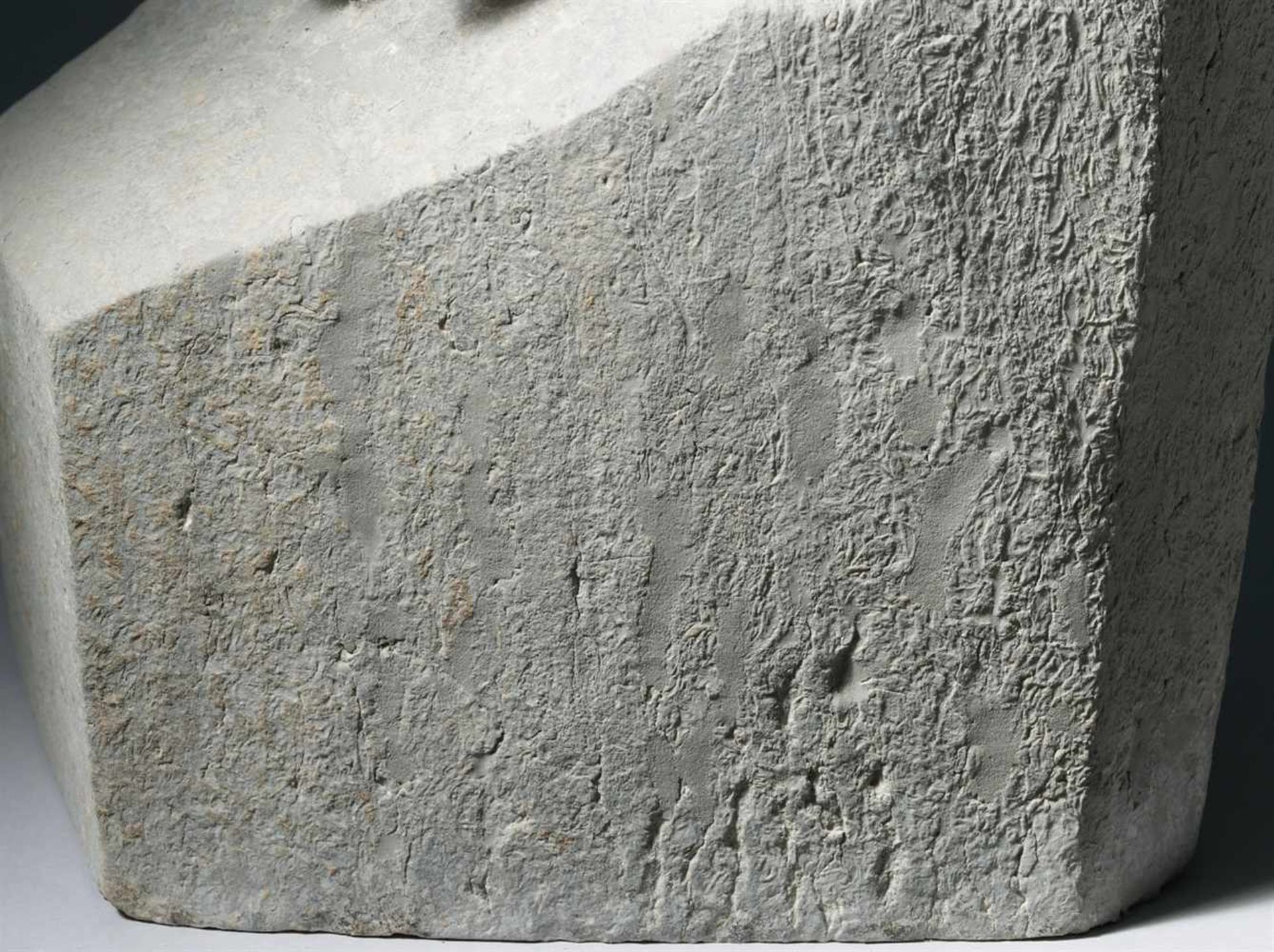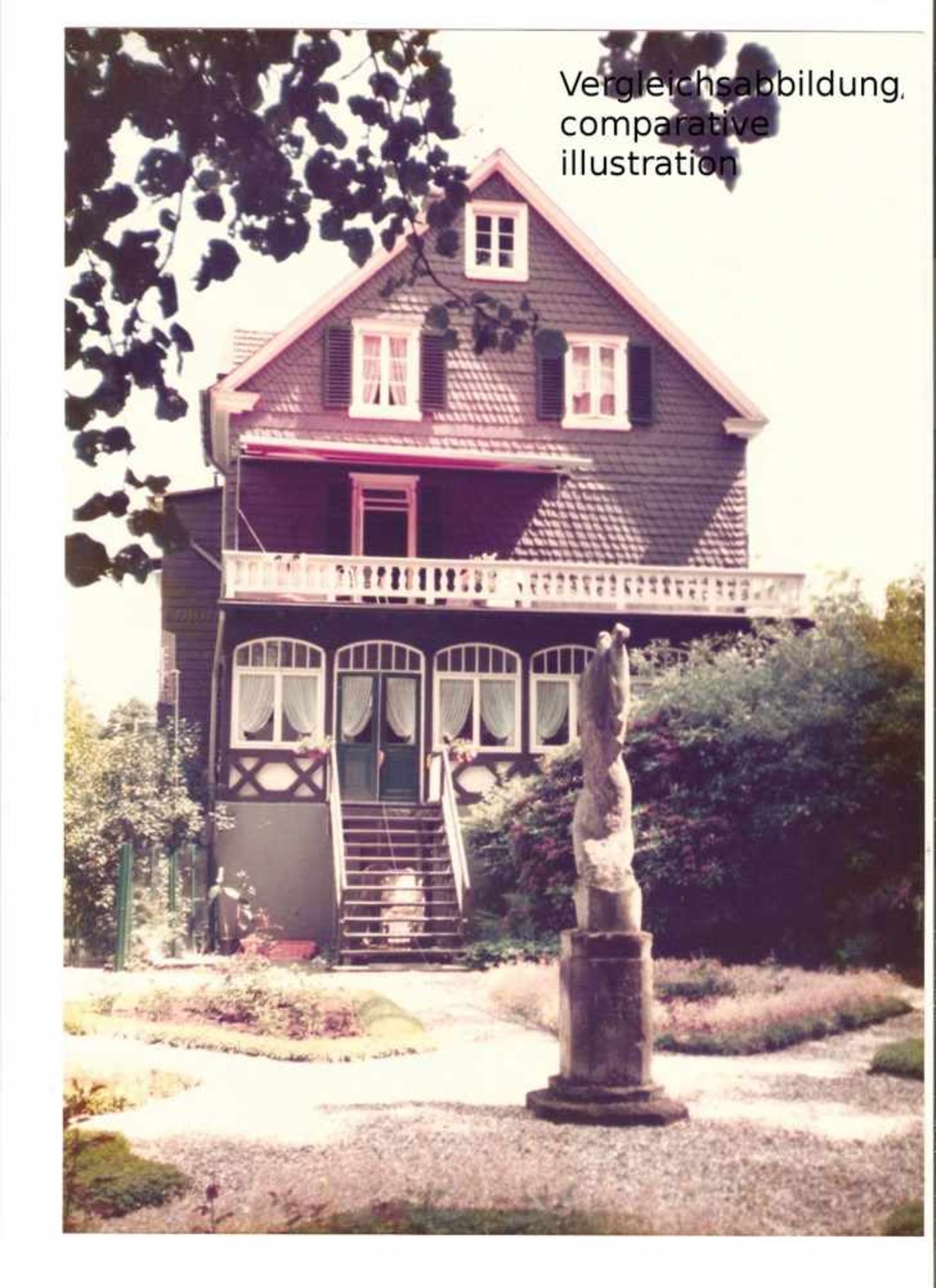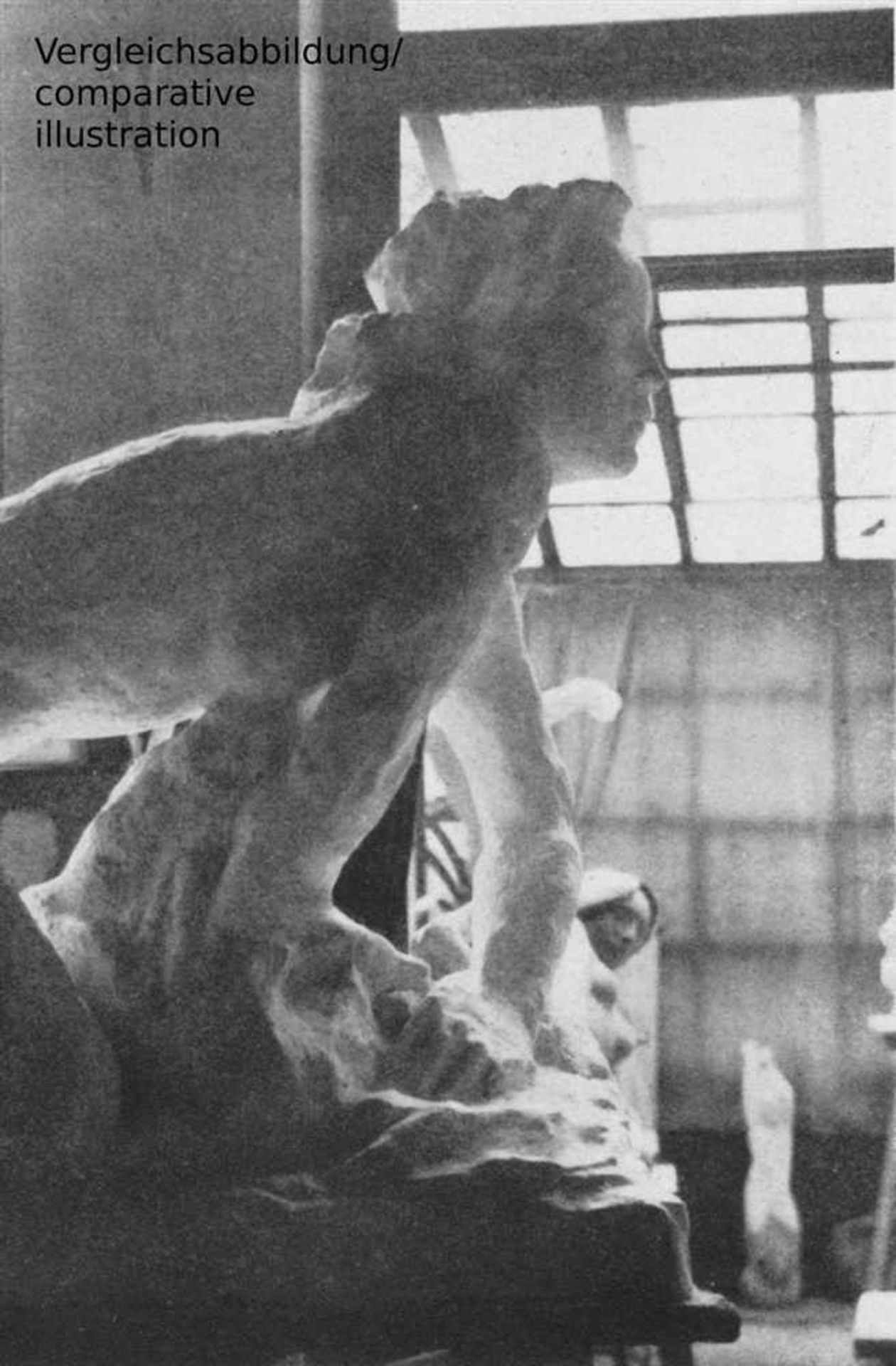327
Georg KolbeZorn (Flamme) Steinplastik. Muschelkalk. Höhe 173,5 cm. Rückseitig am Sockel seitlich
In Modern Art
Zorn (Flamme)
Steinplastik. Muschelkalk. Höhe 173,5 cm. Rückseitig am Sockel seitlich rechts monogrammiert 'GK' (ligiert). - Altersbedingt mit Verwitterungsspuren. Professionell restauriert und gereinigt.
Vgl. Berger 53 (Holzvariante)
Mit einem Gutachten von Ursel Berger, Berlin, vom 29. März 2016
Provenienz
Ehemals Sammlung Schniewind, Neviges; Privatbesitz Nordrhein-Westfalen (seit 1977), seitdem in Familienbesitz
Literatur
Deutsche Kunst und Dekoration, Darmstadt, Band LIII (Okt. 1923 - März 1924), Januar 1924, S. 201 mit Abbildungen ("Holzplastik 'Zorn', Dreiviertel Lebensgrösse 1923."), vgl. auch allgemein den vorlaufenden Artikel von Georg Kolbe, "Begleit-Wort", S. 195-196; Rudolf G. Binding, Vom Leben der Plastik. Inhalt und Schönheit des Werkes von Georg Kolbe, Berlin 1933, S. 28 mit Abb. (Atelierfoto)
Die wiederentdeckte lebensgroße Steinfassung der Skulptur "Zorn" (zu Lebzeiten Kolbes auch "Flamme" genannt) stellt eine wesentliche Ergänzung des bekannten Oeuvres von Georg Kolbe dar. Sie war bislang nur durch ein von der Fotografin und ersten Leiterin des Georg-Kolbe-Museums, Margrit Schwartzkopff (1903-1969), beschriftetes Dokument als vermutet bekannt. Wohl um 1922/1923 entstanden, fand die Steinfassung Aufstellung im Rosengarten der Familie Schniewind in Neviges, wo ihr seit Jahrzehnten, auch nach dem Besitzerwechsel des Anwesens in den 1970er Jahren, bis zum Januar 2016 ein verträumtes wie abgschirmtes Dasein vergönnt war (s. Vergleichsabb.).
Zum Medium, zur Existenz und zu ihrem Verbleib hatte man bislang keinerlei weitere Erkenntnis (vgl. Ursel Berger, Georg Kolbe - Leben und Werk, mit dem Katalog der Kolbe-Plastiken im Georg-Kolbe-Museum, Berlin 1990, S. 262). Das ursprünglich dem Motiv zugrunde liegende Gipsmodell des Künstlers ist auf einem historischen Atelierfoto zu entdecken (s. Vergleichsabb.). Das Kolbe-Museum verwahrt darüberhinaus eine etwas kleinere, farbig gefasste Holzvariante (Höhe 166 cm, s. Berger 53).
"Die vergrößerten Ausführungen sowohl in Stein als auch in Holz [...] stammen von Alfred Dietrich oder Josef Gobes, die beide als Steinmetzen häufig für den Bildhauer arbeiteten und damals eine Ateliergemeinschaft gebildet hatten [...]. Für Holzschnitzarbeiten ist eine Qittung von Dietrich und Gobes vom Juni 1923 im Georg-Kolbe-Museum erhalten. In jener Zeit dürfte auch die Steinfigur hergestellt worden sein. [...] Dass Kolbe 1922/23 einige Figuren in Stein oder Holz - statt wie üblich in Bronze - herstellen ließ, war durch die Inflation begründet: Wegen der galoppierenden Geldentwertung konnte der zeitaufwendige Bronzeguss kaum noch kalkuliert werden, sodass Kolbe auf andere Materialien auswich." (Ursel Berger in ihrem Gutachten).
Berger schliesst nicht aus, dass diese Figur im Zusammenhang mit einem Denkmalsentwurf, vielleicht einem Gefallenen-Denkmal, entwickelt worden ist. Die ausdrucksstarke Skulptur ist Kolbes expressionistischem Werk zuzuordnen und steht stilistisch in der Reihe vergleichbarer Plastiken aus den frühen 1920er Jahren, die aus der inneren Bewegung und dem formalen Antagonismus von Körper und Gewand ihre künstlerische Spannung beziehen. Zur berühmtesten Ikone aus dieser Zeit wurde die Bronze "Adagio", aber auch die Stein- und Holzskulpturen von "Erwachen", "Törichter Engel" oder "Nonne". Inspiriert vom Ausdruckstanz wird über die Geste und die Form ein Seinszustand vermittelt, der auf den Ausdruck einer Emotion, einer starken inneren Bewegung zielt. Ein ins Überzeitliche zielender, hoher Abstraktionsgrad und eine gratige, kubistisch beeinflusste Stilisierung der Details lässt sich dabei beobachten und ist für diese Werkphase typisch. Die raumgreifende, gestreckte Bewegung der hier fast lebensgrossen Figur ist beachtlich: die federnde, leicht nach hinten geworfene Biegung des Leibes, die sich aus den gebeugten Knien ergibt, strafft sich im Oberkörper durch die ausgestreckten Arme mit den geballten Fäusten, die den Mantel wie in einer Geste der Befreiung weit hoch und weg zu zerren scheinen.
Im Vorwort zur ersten Ausstellung der "Freien Secession" 1919 nach dem Krieg hatte Kolbe vermutlich selbst geschrieben: "Zersetzung und Auflösung sind das, was uns der Krieg hinterließ. Kein Einhalt scheint möglich, ein Aufbäumen noch nicht denkbar. Eben deshalb müssen die wenigen Kräfte wieder und wieder zu kommenden Werken gesammelt werden. In diesem Sinne halten wir unsere Ausstellung für notwendig... Wir Lebenden wollen weiter unsere Hände rühren und alle Tage der Kunst weihen." (zit. nach: Ursel Berger, op. cit. Berlin 1990, S. 64). Es wurden damals auch Werke von Wilhelm Lehmbruck gezeigt. Bei der Beerdigung dieses Künstlers waren sich Georg Kolbe und Karl Schmidt-Rottluff begegnet. Sie reisten 1923/1924 gemeinsam nach Italien und Frankreich, und es sollte sie nach diesem Aufbruch und dieser Zäsur eine lebenslange Freundschaft verbinden. Aus diesem Kontext einer aufgewühlten, politisch wie künstlerisch revolutionär gestimmten Zeit ist diese starke, expressiv gestimmte Plastik Georg Kolbes zu verstehen.
Georg Kolbe
Zorn (Flamme)
Stone sculpture. Shell limestone. Height 173.5 cm. Monogrammed 'GK' (joined) on the back right side of the base. - Age-related traces of weathering. Professionally cleaned and restored.
Cf. Berger 53 (Wooden version)
With an expertise by Ursel Berger, Berlin, dated 29 March 2016
Provenance
Formerly collection Schniewind, Neviges; Private possession, North Rhine-Westphalia (since 1977); in family possession since
Literature
Deutsche Kunst und Dekoration, Darmstadt, vol. LIII (Oct. 1923 - March 1924), January 1924, p. 201 with illustrations ("Holzplastik 'Zorn', Dreiviertel Lebensgrösse 1923."), cf. also generally the previous article by Georg Kolbe, "Begleit-Wort", p. 195-196; Rudolf G. Binding, Vom Leben der Plastik. Inhalt und Schönheit des Werkes von Georg Kolbe, Berlin 1933, p. 28 with illus. (photo of the studio)
The rediscovered, life-sized stone version of the sculpture “Zorn” (also called “Flamme” during Kolbe's lifetime) represents a substantial supplement to Georg Kolbe's known oeuvre. Until now it had been known as a probable work only through a document inscribed by Margrit Schwartzkopff (1903-1969), the photographer and first director of the Georg-Kolbe-Museum in Berlin. Presumably created around 1922/1923, the stone version was set up in the rose garden of the Schniewind family in Neviges. Until January of 2016 it enjoyed an enchanted and reclusive existence there for decades, also after the property changed owners in the 1970s (see comparative illus.).
Previously no one had any further knowledge regarding its actual existence, execution and whereabouts (cf. Ursel Berger, Georg Kolbe - Leben und Werk, mit dem Katalog der Kolbe-Plastiken im Georg-Kolbe-Museum, Berlin 1990, p. 262). The artist's plaster model on which the motif was originally based can be detected on a photo of Kolbe's studio (see comparative illus.). A slightly smaller polychrome wooden variation is preserved in the Kolbe Museum (height 166 cm, see Berger 53).
“The enlarged versions executed in stone as well as in wood [...] are by Alfred Dietrich or Josef Gobes, both of whom often worked for the sculptor as stonemasons and had formed a joint studio together at that time [...]. A receipt written by Dietrich and Gobes in June of 1923 for wood-carving work is preserved in the Georg-Kolbe-Museum. It is likely that the stone figure was also produced at that time. [...] The fact that, in 1922/23, Kolbe had several figures produced in stone or wood - instead of the usual bronze - was a result of the inflation crisis: because of money's rampant devaluation, it was scarcely possible to calculate the costs of a time-consuming bronze casting, with the result that Kolbe turned to other m
Zorn (Flamme)
Steinplastik. Muschelkalk. Höhe 173,5 cm. Rückseitig am Sockel seitlich rechts monogrammiert 'GK' (ligiert). - Altersbedingt mit Verwitterungsspuren. Professionell restauriert und gereinigt.
Vgl. Berger 53 (Holzvariante)
Mit einem Gutachten von Ursel Berger, Berlin, vom 29. März 2016
Provenienz
Ehemals Sammlung Schniewind, Neviges; Privatbesitz Nordrhein-Westfalen (seit 1977), seitdem in Familienbesitz
Literatur
Deutsche Kunst und Dekoration, Darmstadt, Band LIII (Okt. 1923 - März 1924), Januar 1924, S. 201 mit Abbildungen ("Holzplastik 'Zorn', Dreiviertel Lebensgrösse 1923."), vgl. auch allgemein den vorlaufenden Artikel von Georg Kolbe, "Begleit-Wort", S. 195-196; Rudolf G. Binding, Vom Leben der Plastik. Inhalt und Schönheit des Werkes von Georg Kolbe, Berlin 1933, S. 28 mit Abb. (Atelierfoto)
Die wiederentdeckte lebensgroße Steinfassung der Skulptur "Zorn" (zu Lebzeiten Kolbes auch "Flamme" genannt) stellt eine wesentliche Ergänzung des bekannten Oeuvres von Georg Kolbe dar. Sie war bislang nur durch ein von der Fotografin und ersten Leiterin des Georg-Kolbe-Museums, Margrit Schwartzkopff (1903-1969), beschriftetes Dokument als vermutet bekannt. Wohl um 1922/1923 entstanden, fand die Steinfassung Aufstellung im Rosengarten der Familie Schniewind in Neviges, wo ihr seit Jahrzehnten, auch nach dem Besitzerwechsel des Anwesens in den 1970er Jahren, bis zum Januar 2016 ein verträumtes wie abgschirmtes Dasein vergönnt war (s. Vergleichsabb.).
Zum Medium, zur Existenz und zu ihrem Verbleib hatte man bislang keinerlei weitere Erkenntnis (vgl. Ursel Berger, Georg Kolbe - Leben und Werk, mit dem Katalog der Kolbe-Plastiken im Georg-Kolbe-Museum, Berlin 1990, S. 262). Das ursprünglich dem Motiv zugrunde liegende Gipsmodell des Künstlers ist auf einem historischen Atelierfoto zu entdecken (s. Vergleichsabb.). Das Kolbe-Museum verwahrt darüberhinaus eine etwas kleinere, farbig gefasste Holzvariante (Höhe 166 cm, s. Berger 53).
"Die vergrößerten Ausführungen sowohl in Stein als auch in Holz [...] stammen von Alfred Dietrich oder Josef Gobes, die beide als Steinmetzen häufig für den Bildhauer arbeiteten und damals eine Ateliergemeinschaft gebildet hatten [...]. Für Holzschnitzarbeiten ist eine Qittung von Dietrich und Gobes vom Juni 1923 im Georg-Kolbe-Museum erhalten. In jener Zeit dürfte auch die Steinfigur hergestellt worden sein. [...] Dass Kolbe 1922/23 einige Figuren in Stein oder Holz - statt wie üblich in Bronze - herstellen ließ, war durch die Inflation begründet: Wegen der galoppierenden Geldentwertung konnte der zeitaufwendige Bronzeguss kaum noch kalkuliert werden, sodass Kolbe auf andere Materialien auswich." (Ursel Berger in ihrem Gutachten).
Berger schliesst nicht aus, dass diese Figur im Zusammenhang mit einem Denkmalsentwurf, vielleicht einem Gefallenen-Denkmal, entwickelt worden ist. Die ausdrucksstarke Skulptur ist Kolbes expressionistischem Werk zuzuordnen und steht stilistisch in der Reihe vergleichbarer Plastiken aus den frühen 1920er Jahren, die aus der inneren Bewegung und dem formalen Antagonismus von Körper und Gewand ihre künstlerische Spannung beziehen. Zur berühmtesten Ikone aus dieser Zeit wurde die Bronze "Adagio", aber auch die Stein- und Holzskulpturen von "Erwachen", "Törichter Engel" oder "Nonne". Inspiriert vom Ausdruckstanz wird über die Geste und die Form ein Seinszustand vermittelt, der auf den Ausdruck einer Emotion, einer starken inneren Bewegung zielt. Ein ins Überzeitliche zielender, hoher Abstraktionsgrad und eine gratige, kubistisch beeinflusste Stilisierung der Details lässt sich dabei beobachten und ist für diese Werkphase typisch. Die raumgreifende, gestreckte Bewegung der hier fast lebensgrossen Figur ist beachtlich: die federnde, leicht nach hinten geworfene Biegung des Leibes, die sich aus den gebeugten Knien ergibt, strafft sich im Oberkörper durch die ausgestreckten Arme mit den geballten Fäusten, die den Mantel wie in einer Geste der Befreiung weit hoch und weg zu zerren scheinen.
Im Vorwort zur ersten Ausstellung der "Freien Secession" 1919 nach dem Krieg hatte Kolbe vermutlich selbst geschrieben: "Zersetzung und Auflösung sind das, was uns der Krieg hinterließ. Kein Einhalt scheint möglich, ein Aufbäumen noch nicht denkbar. Eben deshalb müssen die wenigen Kräfte wieder und wieder zu kommenden Werken gesammelt werden. In diesem Sinne halten wir unsere Ausstellung für notwendig... Wir Lebenden wollen weiter unsere Hände rühren und alle Tage der Kunst weihen." (zit. nach: Ursel Berger, op. cit. Berlin 1990, S. 64). Es wurden damals auch Werke von Wilhelm Lehmbruck gezeigt. Bei der Beerdigung dieses Künstlers waren sich Georg Kolbe und Karl Schmidt-Rottluff begegnet. Sie reisten 1923/1924 gemeinsam nach Italien und Frankreich, und es sollte sie nach diesem Aufbruch und dieser Zäsur eine lebenslange Freundschaft verbinden. Aus diesem Kontext einer aufgewühlten, politisch wie künstlerisch revolutionär gestimmten Zeit ist diese starke, expressiv gestimmte Plastik Georg Kolbes zu verstehen.
Georg Kolbe
Zorn (Flamme)
Stone sculpture. Shell limestone. Height 173.5 cm. Monogrammed 'GK' (joined) on the back right side of the base. - Age-related traces of weathering. Professionally cleaned and restored.
Cf. Berger 53 (Wooden version)
With an expertise by Ursel Berger, Berlin, dated 29 March 2016
Provenance
Formerly collection Schniewind, Neviges; Private possession, North Rhine-Westphalia (since 1977); in family possession since
Literature
Deutsche Kunst und Dekoration, Darmstadt, vol. LIII (Oct. 1923 - March 1924), January 1924, p. 201 with illustrations ("Holzplastik 'Zorn', Dreiviertel Lebensgrösse 1923."), cf. also generally the previous article by Georg Kolbe, "Begleit-Wort", p. 195-196; Rudolf G. Binding, Vom Leben der Plastik. Inhalt und Schönheit des Werkes von Georg Kolbe, Berlin 1933, p. 28 with illus. (photo of the studio)
The rediscovered, life-sized stone version of the sculpture “Zorn” (also called “Flamme” during Kolbe's lifetime) represents a substantial supplement to Georg Kolbe's known oeuvre. Until now it had been known as a probable work only through a document inscribed by Margrit Schwartzkopff (1903-1969), the photographer and first director of the Georg-Kolbe-Museum in Berlin. Presumably created around 1922/1923, the stone version was set up in the rose garden of the Schniewind family in Neviges. Until January of 2016 it enjoyed an enchanted and reclusive existence there for decades, also after the property changed owners in the 1970s (see comparative illus.).
Previously no one had any further knowledge regarding its actual existence, execution and whereabouts (cf. Ursel Berger, Georg Kolbe - Leben und Werk, mit dem Katalog der Kolbe-Plastiken im Georg-Kolbe-Museum, Berlin 1990, p. 262). The artist's plaster model on which the motif was originally based can be detected on a photo of Kolbe's studio (see comparative illus.). A slightly smaller polychrome wooden variation is preserved in the Kolbe Museum (height 166 cm, see Berger 53).
“The enlarged versions executed in stone as well as in wood [...] are by Alfred Dietrich or Josef Gobes, both of whom often worked for the sculptor as stonemasons and had formed a joint studio together at that time [...]. A receipt written by Dietrich and Gobes in June of 1923 for wood-carving work is preserved in the Georg-Kolbe-Museum. It is likely that the stone figure was also produced at that time. [...] The fact that, in 1922/23, Kolbe had several figures produced in stone or wood - instead of the usual bronze - was a result of the inflation crisis: because of money's rampant devaluation, it was scarcely possible to calculate the costs of a time-consuming bronze casting, with the result that Kolbe turned to other m
Modern Art
Auktionsdatum
Ort der Versteigerung
Für Kunsthaus Lempertz Versandinformtation bitte wählen Sie +49 (0)221 9257290.
Wichtige Informationen
Different terms per lot.
In any case: 3 % additional premium for sales to internet bidders.
Standard:
24,00 % Aufgeld auf den Zuschlagspreis
(20,00 % für den 400.001 EUR übersteigenden Anteil des Zuschlags)
19,00 % MwSt. auf Aufgeld und Kosten nicht ausgewiesen und nicht erstattbar; Differenzbesteuerung
Also:
35,00 % Aufgeld auf den Zuschlagspreis
(31,00 % für den 400.000 EUR übersteigenden Anteil des Zuschlags)
Differenzbesteuerung, MwSt. enthalten, aber nicht ausgewiesen, nicht erstattbar
Also:
24,00 % Aufgeld auf den Zuschlagspreis
(20,00 % für den 400.001 EUR übersteigenden Anteil des Zuschlags)
7,00 % verauslagte Einfuhrumsatzsteuer auf den Zuschlagspreis, erstattbar bei Export aus der EU
19,00 % MwSt. auf Aufgeld und Kosten nicht ausgewiesen und nicht erstattbar; Differenzbesteuerung
Additionla fees because of artists' resale rights apply.
AGB
Conditions of Sale
1. The art auction house, Kunsthaus Lempertz (henceforth referred to as Lempertz), conducts public auctions in terms of § 383 paragraph 3 sentence 1 of the Civil Code as commissioning agent on behalf of the accounts of submitters, who remain -anonymous. With regard to its auctioneering terms and conditions drawn up in other languages, the German version remains the official one.
2. The auctioneer reserves the right to divide or combine any catalogue lots or, if it has special reason to do so, to offer any lot for sale in an order different from that given in the catalogue or to withdraw any lot from the sale.
3. All lots put up for sale may be viewed and inspected prior to the auction. The catalogue specifications and related specifications appearing on the internet, which have both been compiled in good conscience, do not form part of the contractually agreed to conditions. These specifications have been derived from the status of the information available at the time of compiling the catalogue. They do not serve as a guarantee in legal terms and their purpose is purely in the information they provide. The same applies to any reports on an item’s condition or any other information, either in oral or written form. Certificates or certifications from artists, their estates or experts relevant to each case only form a contractual part of the agreement if they are specifically mentioned in the catalogue text. The state of the item is generally not mentioned in the catalogue. Likewise missing specifications do not constitute an agreement on quality. All items are used goods.
The gold content of objects without fineness stamps are ascertained using an acid test. The size and quality of gemstones are ascertained within the settings, unless mentioned otherwise. Assessments of the clarity and colour of gemstones are subject to the subjective perception. Minor divergences from the values provided do not represent deficiencies. References to gemmological certifications are used purely for informational purposes, and do not provide a guarantee. The watches listed have been opened to be catalogued, but we cannot guarantee for their accuracy and function.
4. Warranty claims are excluded. In the event of variances from the catalogue -descriptions, which result in negation or substantial diminution of value or suitability, and which are reported with due justification within one year after handover, Lempertz nevertheless undertakes to pursue its rights against the seller through the courts; in the event of a successful claim against the seller, Lempertz will reimburse the buyer only the total purchase price paid. Over and above this, Lempertz undertakes to reimburse its commission within a given period of two years after the date of the sale if the object in question proves not to be authentic.
5. Claims for compensation as the result of a fault or defect in the object auctioned or damage to it or its loss, regardless of the legal grounds, or as the result of variances from the catalogue description or statements made elsewhere are excluded unless Lempertz acted with wilful intent or gross negligence; the liability for bodily injury or damages caused to health or life remains unaffected. In other regards, point 4 applies.
6. Submission of bids. Bids in attendance: The floor bidder receives a bidding number on presentation of a photo ID. Lempertz reserves the right to grant entry to the auction. If the bidder is not known to Lempertz, registration must take place 24 hours before the auction is due to begin in writing on presentation of a current bank reference. Bids in absentia: Bids can also be submitted either in writing, -telephonically or via the internet. The placing of bids in absentia must reach -Lempertz 24 hours before the auction to ensure the proper processing thereof. The item must be mentioned in the bid placed, together with ticket number and item description. In the event of ambiguities, the listed ticket number -becomes applicable. The placement of a bid must be signed by the applicant. The regulations regarding revocations and the right to return the goods in the case of long distance agreements (§ 312b – d of the Civil Code) do not -apply. Telephonic bids: Establishing and maintaining a connection cannot be vouched for. In submitting a bid placement, the bidder declares that he agrees to the recording of the bidding process. Bids via the internet: They will only be accepted by Lempertz if the bidder registered himself on the internet website beforehand. Lempertz will treat such bids in the same way as bids in writing.
7. Carrying out the auction. The hammer will come down when no higher bids are submitted after three calls for a bid. In extenuating circumstances, the auctioneer reserves the right to bring down the hammer or he can refuse to accept a bid. If several individuals make the same bid at the same time, and after the third call, no higher bid ensues, then the ticket becomes the deciding factor. The auctioneer can retract his acceptance of the bid and auction the item once more if a higher bid that was submitted on time, was erroneously overlooked and immediately queried by the bidder, or if any doubts regarding its acceptance arise. Bids are only played to an absolute maximum by Lempertz if this is deemed necessary to outbid another bid. The auctioneer can bid on behalf of the submitter up to the agreed limit, without revealing this and irrespective of whether other bids are submitted. Even if bids have been placed and the hammer has not come down, the auctioneer is only liable to the bidder in the event of premeditation or gross negligence.
8. Once a lot has been knocked down, the successful bidder is obliged to buy it. If a bid is accepted conditionally, the bidder is bound by his bid until four weeks after the auction unless he immediately withdraws from the conditionally accepted bid. From the fall of the hammer, possession and risk pass directly to the buyer, while ownership passes to the buyer only after full payment has been received.
9. Up to a hammer price of € 400.000.- a premium of 24 % calculated on the hammer price plus 19 % value added tax calculated (VAT) on the surcharge only is levied. The premium will be reduced to 20 % (plus VAT) on any amount surpassing € 400.000 (margin scheme). On lots which are characterized by ** an additional 7 % for import tax will be added. On lots which are characterised by an *, the buyer shall pay a premium of 24 % on a hammer price up to € 400.000 and 20 % on the surpassing amount; onto this (hammer price and premium) the statutory VAT of 19 % will be added (regular scheme). Exports to third (i.e. non-EU) countries will be exempt from VAT, and so will be exports made by companies from other EU member states if they state their VAT identification number. For original works of art, whose author died after 31.12.1943, a charge of 1,9 % on the hammer price will be levied for the droit de suite. The maximum charge is € 12.500.-. If a buyer exports an object to a third country personally, the VAT will be refunded, as soon as Lempertz receives the export and import papers. All invoices issued on the day of auction or soon after remain under provision.
10. Successful bidders attending the auction in person shall forthwith upon the purchase pay to Lempertz the final price (hammer price plus premium and VAT) in Euro. Payments by foreign buyers who have bid in writing or by proxy shall also be due forthwith upon the purchase, but will not be deemed to have been delayed if received within ten days of the invoice date. Bank transfers are to be exclusively in Euros. The request for an alteration of an auction invoice to a person other than the bidder has to be made immediately after the auction. Lempertz however also reserves the right to refuse such a request if it is deemed appropriate.
11. In the case of payment default, Lempertz will charge interest on the outstanding amount at a rate of 1 % of the gross price per month or part month. If the buyer defaults in payment, Lempertz may at its discretion insist on performance of the purchase contract or, after allowing a period of grace, claim damages for non-performance. In the latter case, Lempertz may determine the amount of the damages by putting the lot or lots up for auction again, in which case the defaulting buyer will bear the amount of any reduction in the proceeds compared with the earlier auction, plus the cost of resale, including the premium.
12. Buyers must take charge of their purchases immediately after the auction. Once a lot has been sold, the auctioneer is liable only for wilful intent or gross negligence. Lots will not, however, be surrendered to buyers until full payment has been received. Without exception, shipment will be at the expense and risk of the buyer. Purchases which are not collected within four weeks after the auction may be stored and insured by Lempertz on behalf of the buyer and at its expense in the premises of a freight agent. If Lempertz stores such items itself, it will charge 1 % of the hammer price for insurance and storage costs.
13. As far as this can be agreed, the place of performance and jurisdiction is Cologne. German law applies; the provisions of the United Nations Convention on Contracts for the International Sale of Goods, CISG are not applicable. Should any provision herein be wholly or partially ineffective, this will not affect the validity of the remaining provisions.
Henrik Hanstein, sworn public auctioneer
Takuro Ito, Auctioneer
























